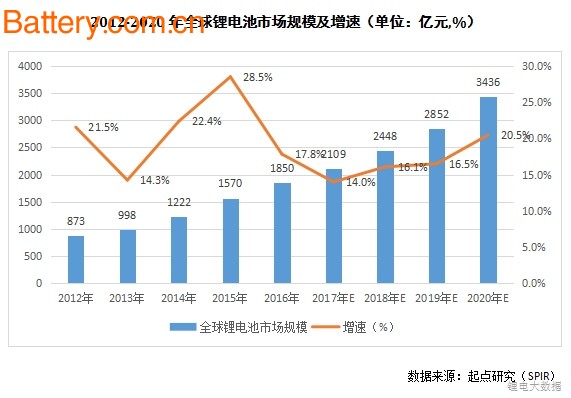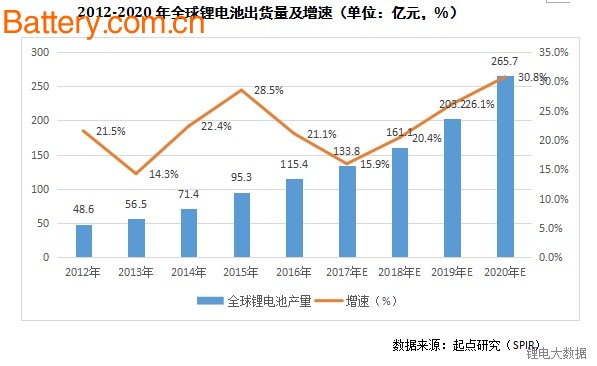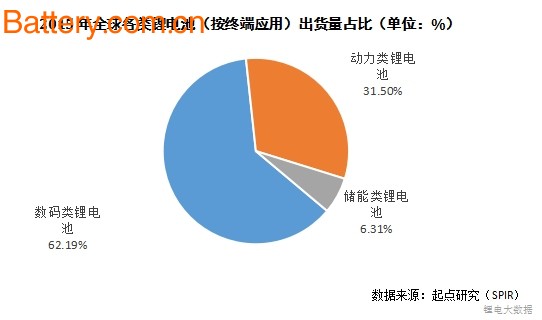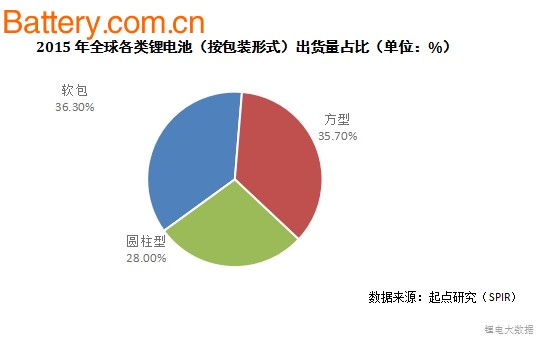In 2020, the global lithium battery output value will exceed 340 billion yuan
With the widespread application and popularization of digital electronic products and new energy power products, the lithium-ion battery industry has achieved rapid development, and has formed an industrial chain system with high degree of specialization and clear division of labor. After more than ten years of development, the world The lithium-ion battery market has grown rapidly.
The starting point study (SPIR) statistics show that in 2016, the global lithium battery cell output value reached 185 billion yuan, an increase of 17.8% compared with 2015. It is estimated that by 2020, the global lithium battery cell output value will reach 343.6 billion yuan.

In the past two years, the global 3C lithium battery market has become increasingly mature. The power lithium battery market has become the largest engine for the rapid growth of the global lithium battery market. As far as the regional market is concerned, China has become the most active area for lithium battery development in the world.
The starting point study (SPIR) statistics show that since 2010, the global lithium battery output has grown at an average annual rate of more than 25%. In 2016, the global lithium battery shipments reached 115.4GWH, an increase of 21.1% over the previous year. It is estimated that in 2020, global lithium battery shipments will reach 265.7GWH, which is 2.5 times that of 2016.

According to the starting point study (SPIR) statistics, the total global lithium battery shipments reached 95.29 GWH in 2015, an increase of 33.5% over the previous year. Among them, the sales of power batteries for electric vehicles , tricycles, electric bicycles, and unicycles reached 31.50 GWH, accounting for about 30% of total lithium battery shipments. In 2016, global lithium battery shipments reached 115.38GWH, of which power lithium battery shipments reached 45.33GWH, accounting for 40%.

Among the three types of lithium battery cells, the research data from the starting point (SPIR) shows that in 2015, the output of soft-packed batteries and square-shaped batteries was equivalent, and the shipments were all around 36 GWH, both exceeding the cylindrical cells. The demand for cylindrical batteries is 26.68GWH, accounting for about 28%. With the development of the new energy vehicle market, the demand for the other type of batteries will be further expanded in the future. In 2016, square batteries accounted for about 40% of the market.

"Gravity Die Casting. A permanent mould casting process, where the molten metal is poured from a vessle of ladle into the mould, and cavity fills with no force other than gravity, in a similar manner to the production of sand castings, although filling cn be controlled by tilting the die."
Gravity Die Casting
Sometimes referred to as Permanent Mould, GDC is a repeatable casting process used for non-ferrous alloy parts, typically aluminium, Zinc and Copper Base alloys.
The process differs from HPDC in that Gravity- rather than high pressure- is used to fill the mould with the liquid alloy.
GDC is suited to medium to high volumes products and typically parts are of a heavier sections than HPDC, but thinner sections than sand casting.
There are three key stages in the process.
- The heated mould [Die or Tool] is coated with a die release agent. The release agent spray also has a secondary function in that it aids cooling of the mould face after the previous part has been removed from the die.
- Molten metal is poured into channels in the tool to allow the material to fill all the extremities of the mould cavity. The metal is either hand poured using steel ladles or dosed using mechanical methods. Typically, there is a mould [down sprue" that allows the alloy to enter the mould cavity from the lower part of the die, reducing the formation of turbulence and subsequent porosity and inclusions in the finished part.
- Once the part has cooled sufficiently, the die is opened, either manually or utilising mechanical methods.
Advantages
- Good dimensional accuracy
- Smoother cast surface finish than sand casting
- Improved mechanical properties compared to sand casting
- Thinner walls can be cast compared to sand casting
- Reverse draft internal pockets and forms can be cast in using preformed sand core inserts
- Steel pins and inserts can be cast in to the part
- Faster production times compared to other processes.
- Once the tolling is proven, the product quality is very repeatable.
- Outsourced Tooling setup costs can be lower than sand casting.
Gravity Casting Parts,Aluminum Alloy Gravity Casting Parts,Aluminum Gravity Die Casting Parts,Gravity Casting Aluminum Parts
HSI INDUSTRIEL LTD , https://www.hsiindustriel.com